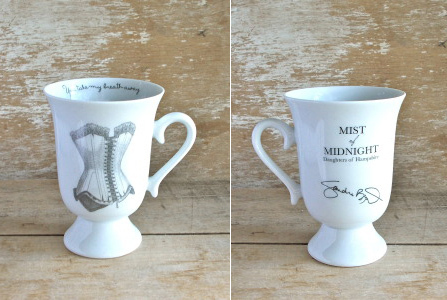Sandra Byrd's Blog, page 17
February 14, 2015
Laudanum: Victorian Elixir
 What magical elixir could be recommended, in Victorian times, for conditions as wide ranging as infant tooth discomfort, loose stools, PMS, and insomnia? The answer, of course, was laudanum: the opium-derived narcotic painkiller, mood-lifter, and life destroyer.
What magical elixir could be recommended, in Victorian times, for conditions as wide ranging as infant tooth discomfort, loose stools, PMS, and insomnia? The answer, of course, was laudanum: the opium-derived narcotic painkiller, mood-lifter, and life destroyer.
“Laudanum, another opium derivative, was, like morphia, freely available from chemists, and never very expensive. It was a mild soporific and painkiller but a supreme sedative, and particularly helpful at deathbeds. …There was no restriction imposed on chemists in respect of the sale of laudanum and other such sedatives,” recounts Liza Picard in her book, Victorian London: The Tale of a City.
Addictive God of Sleep
Laudanum contained all the opium alkaloids, including morphine and codeine. In order to make its bitter taste more palatable, it was often blended into a syrup which would contain vanilla, spices, sugar, and citrus, in addition to alcohol. arbara Hodgson, in her book, In the Arms of Morpheus: The Tragic History of Laudanum, Morphine, and Patent Medicines, says that “Opium, and after 1820, morphine, was mixed with everything imaginable: mercury, hashish, cayenne pepper, ether, chloroform, belladonna, whiskey, wine and brandy.” Indeed, it was the combination of opium and alcohol which made it so effective, addictive, and deadly. Laudanum dulled or removed pain, produced vivid dreams, and led to deep and also disrupted sleep. There is good reason morphine is named after Morpheus, god of sleep.
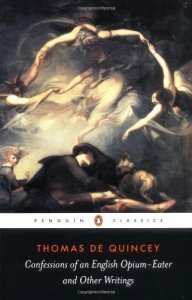 Euphoria… and Hallucinations
Euphoria… and Hallucinations
Opium has been widely in use as a medicinal since the time of Hippocrates, he of the famous oath. In addition to its pain relieving, sleep inducing properties it brought about a sense of euphoria. Researcher Rudolf Gelpke says, “Opium…loosens the soul from its entanglements with everyday things and the outer world. (It) makes one silent and gentle. It inspires and gives flight to the imagination.”
For the downsides of its use, a brief reading of Confessions of an Opium Eater by Thomas de Quincey (free kindle copy here) might be instructive; he recounts the paranoia, delusions, and hallucinations he suffered, even while he consented to continue indulging his addiction.
Fame and Infamy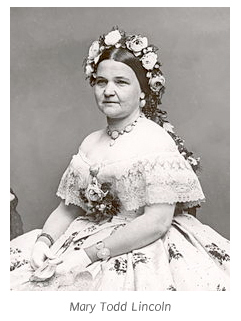 In the Victorian Era, laudanum was used world-round, particularly by artists, writers, and woman. The Encyclopedia of Psychotropic Plants claims that Edgar Allan Poe wrote most of his work while under its influence. Baudelaire, a sometimes collaborator with Poe, published a collection of poems entitled, The Flowers of Evil, which explored his experiences with opium. Mary Lincoln Todd was said to be addicted to laudanum as was Elizabeth Barrett Browning. Like addicts of any ages, once in the grasp of the drug it was hard to free oneself. Then, as now, certain people were more disposed to fall under the guile of opiates than others.
In the Victorian Era, laudanum was used world-round, particularly by artists, writers, and woman. The Encyclopedia of Psychotropic Plants claims that Edgar Allan Poe wrote most of his work while under its influence. Baudelaire, a sometimes collaborator with Poe, published a collection of poems entitled, The Flowers of Evil, which explored his experiences with opium. Mary Lincoln Todd was said to be addicted to laudanum as was Elizabeth Barrett Browning. Like addicts of any ages, once in the grasp of the drug it was hard to free oneself. Then, as now, certain people were more disposed to fall under the guile of opiates than others.
Remarkably, although it is now highly regulated, laudanum does remain available even today, by prescription, in the US and the UK. It cannot, however, be recommended.
Angels Among Us
Our family was in London for a holiday —working and pleasure—and we’d rented a tiny flat with a lovely view of the Thames, but in an area my daughter declared to be teetering on “the edge of sketch.” After a day’s sightseeing, we deposited our teenagers at that flat whilst my husband and I set out for a stroll. There was a hole-in-the-wall restaurant not too far away, I explained, that I’d read had wonderful take-away food. We could bring back some for dinner.
We set out walking, and walking, and walking, and it wasn’t too long till we realized we were blindingly lost. We had a small map which didn’t do much once we were in the thinner arteries of the city, in a less travelled neighborhood which clearly recognized us as not of their own. There were few people walking, fewer still loitering in door stops, smoking as they eyed us warily.
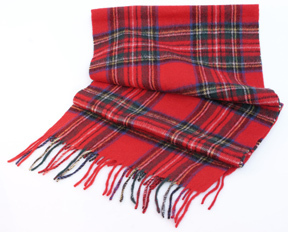 We stood in an empty intersection, turning this way and that, wondering what to do next and praying for help. After a nearly clockwise spin, my husband turned back from looking down an empty street to be surprised to find a small, elderly man with a neat white beard appear from nowhere; he stood in front of a locked and barred door which had just been vacant. Approaching my husband he asked in a thick Scots accent, “Which way are ye going?”
We stood in an empty intersection, turning this way and that, wondering what to do next and praying for help. After a nearly clockwise spin, my husband turned back from looking down an empty street to be surprised to find a small, elderly man with a neat white beard appear from nowhere; he stood in front of a locked and barred door which had just been vacant. Approaching my husband he asked in a thick Scots accent, “Which way are ye going?”
“That way,” my husband said hesitantly, pointing west.
“That’s where I’m going too,” the stranger replied.
“No,” I turned back around, surprised to see the man and certain that the restaurant was in another direction. “That way.” I pointed southeast.
“That’s where I’m going, too,” the Scotsman said.
My husband and I exchanged a glance above the stranger’s head. Didn’t he know where he was going, either?
I explained that we were Americans – he grinned, clearly he could already guess this by our accents. We wanted to locate a restaurant I’d read about online but had become a challenge to find.
“Follow me,” he commanded. “I know the place.” I was nervous, but what choice did we have? I looked him over and noticed my husband did, too. The man was slight, perfectly dressed in an expensive navy wool coat with a tartan scarf wrapped around his neck and a blue felt hat on his head. He was slight and my husband could definitely “take him” if need be. I glanced at the man’s shoes. They were well worn, almost falling apart, a distinct contrast to his well-cared for clothing. I wrote it off to Scots frugality and we followed him.
Within a minute or two, he was leading us down an alley, which appeared to be completely deserted. Was he leading us somewhere to be jumped? I wondered. It was off the beaten path, and the buildings were so high on either side that we would be completely hidden from view. I glanced at my husband, who was between us and making light, awkward conversation with the man, and he nodded. After a few minutes of twists and turns we arrived at the start of a long street, nearly abandoned, with business after business on either side shuttered and barred off, a long, nearly unbroken row that eventually met with a busy crossroad about a half mile down.
We stood in front of the restaurant and the man nodded. “Here you are, then.” He looked down the long street. “When you’ve finished, you walk straight and quickly till you come to the main road, and then turn right.” He had not asked us to where we were returning, so I did not know how he knew which way we should go. I realized we hadn’t even even mentioned the name of this restaurant! He spoke up again. “Do not go back the way you came,” he said in a strong voice. “It’s nae safe for you.”
We nodded and, still somewhat bewildered and stunned, said nothing, just stepped inside the restaurant. Within a second I said to my husband, “Oh! We forgot to thank him!” I turned and went outside, but he was gone. I quickly walked several steps in one direction, and then the next, but there were no breaks in the walls of businesses and none of the surrounding buildings were even open; our Scotsman was nowhere to be found. Within the previous few seconds, he had completely disappeared.
My heart quickened and I felt wrapped in a holy hush; within my spirit, I knew. He’d been sent to help us, presented in a way that would make us feel safe and comforted, but in the well-worn shoes of someone who had walked many miles in service.
We bought our delicious food and walked toward the road, as we’d been instructed. It was true, then, what scripture promised. That angels are sent to guard our way 1, to protect and guide us, to serve, protect, and be messengers of God: “Do not go back the way you came, it’s not safe for ye” is timeless truth for all who walk the path of faith, is it not? Angels are not just for “back then” and not just for others, but for us, all of us, here and now, those of us who will inherit salvation 2.
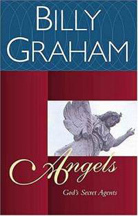 Billy Graham, in his book, Angels: God’s Secret Agents, recalls a similar situation wherein a group of American troops trapped up north during the Korean war were freezing, starving, and lost. After prayer and praise, they found themselves suddenly confronted with an English speaking South Korean who led them through the mountains to safety behind their own lines. “When they looked up to thank him,” Graham writes, “they found that he had disappeared.” I read this account some years after our London encounter, but it resonated perfectly with our experience.
Billy Graham, in his book, Angels: God’s Secret Agents, recalls a similar situation wherein a group of American troops trapped up north during the Korean war were freezing, starving, and lost. After prayer and praise, they found themselves suddenly confronted with an English speaking South Korean who led them through the mountains to safety behind their own lines. “When they looked up to thank him,” Graham writes, “they found that he had disappeared.” I read this account some years after our London encounter, but it resonated perfectly with our experience.
Life can be difficult; we can become lost, bewildered, confused, and in dangers of various sorts. God, however, promises that he will never leave us, He is a very present help in times of trouble 3. Sometimes, to our unexpected pleasure, that help arrives in angelic form, of which we mostly, at the time, remain unaware 4.

Notes:
Psalm 91:11; Exodus 23:20 ↩Hebrews 1:14 ↩Psalm 46:1 ↩Hebrews 13:2 ↩February 9, 2015
Mist of Midnight Giveaway!
February 5, 2015
Victorian Secrets
Most everyone has a picture in mind, from the movies, a book, or a blog, of a Victorian woman grasping her dressing table while a servant or ladies’ maid tugs the cords to her corset, hoping for that famously narrow waist. Although corsets are often associated with the highborn, in reality they were worn by young ladies across the economic spectrum, and on both sides of the pond. Good mothers ensured their daughters started young. Sarah Chrisman, author of Victorian Secrets says, “Victorian girls had training corsets in much the way modern girls have training bras: simpler than their mother’s garments, different in form, but kindred in spirit.”
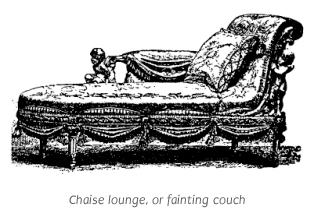 Fainting Couches
Fainting Couches
Were the mothers’ garments always tightly laced? No. Sally Mitchell, author of Daily Life in Victorian England reminds us that, “Although Victorian corsets were usually boned and sometimes padded to create a fashionable silhouette, they were not necessarily tightly laced. Both physicians and feminist dress-reformers harped on the dangers of tight lacing.” Those dangers ranged from minor troubles, such as indigestion and skin irritation, to more substantial dangers including injuries to the breasts and ribs, as well as displacement of or damage to internal organs. Author Liza Picard, in her book, Victorian London: The Tale of a City 1840-1870, says that, “This unnatural constriction surely helps to explain the habits of Victorian ladies, of fainting, and preferring to lie on the sofa, to taking exercise.”
Just after the corset came the crinoline. Victoriana Magazine instructs, “The word crinoline originally referred to a stiff fabric with a weft of horse hair and a warp of cotton or linen thread (the Latin crinis meaning hair and linum meaning flax). This fabric made its first appearance in fashion in the 1830s when it was used in women’s petticoats to support and shape the growing length and diameter of the early Victorian dress. Often a petticoat of this stiffened fabric was worn with up to six starched petticoats in an attempt to achieve the big skirt effect; these tangling petticoats were heavy, bulky and generally uncomfortable.
Indelicate, Expensive, Dangerous and Hideous
Liza Picard writes, “The most famous under-garment worn by Victorian women was the crinoline. It attracted so much publicity that the casual reader of fashion magazines might think everyone wore one. Queen Victoria never did. She even went into print on them, in a letter addressed to the Ladies of England; they were ‘indelicate, expensive, dangerous and hideous.’”
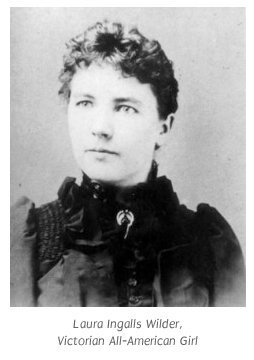 Little House in a Harness
Little House in a Harness
In America, restrictive, lady-like undergarments were not universally beloved, either. Beatrice Gormley, in her biography of Laura Ingalls Wilder tells us the iconic All-American Victorian Girl didn’t take kindly to corsets, which she referred to as horse harnesses. “Another thing Laura felt stubborn about was corsets, the undergarments ladies wore to pinch in their waists. Before Mary had left for college, Ma insisted that Mary and Laura both start wearing corsets. ‘You are young ladies now,’ she said in her gentle but final tone. Mary wore her corset meekly, even at night… but Laura rebelled…She never wore her corset as much as her mother thought she should, or laced as tight as other girls did.”
Why did young women wear those tightly laced corsets night and day? “Before I was married,” Ma warned, “Your father could span my waist with his two hands.” Just like Chinese women with their bound feet, American and British women were bound, too, to attract a man.
Fire Hazards Crinolines posed one further danger beyond that done by contorting the body. One could conceivably bump into one of a dozen gas or candle-lit lamps about the home, catch fire, and be unable to undress quickly enough to save your life. Sadly, this was the fate of many women.
Crinolines posed one further danger beyond that done by contorting the body. One could conceivably bump into one of a dozen gas or candle-lit lamps about the home, catch fire, and be unable to undress quickly enough to save your life. Sadly, this was the fate of many women.
Fashion to die for, indeed.
January 31, 2015
Jane Kirkpatrick Endorsement, Mist
One of the many things I love about a Sandra Byrd novel is knowing that her words will transport me to another place and time, win me over with intriguing and complex characters and that I’ll savor every word. Mist of Midnight is no exception. I loved this book! Sandra Byrd could belong to the writing group of the Bronte sisters if they’d had one. Wuthering Heights and Jane Eyre along with crumbling mansions, mysterious distant cousins and one woman’s journey to prove who she really is are just few layers that ripple through the mists. Bravo, Sandra! Another winner. Jane Kirkpatrick, Award-winning author of A Light in the Wilderness.
January 20, 2015
Mist of Midnight ARC giveaway!
January 11, 2015
Anne Girard
“From the first word to the last, Mist of Midnight is a completely absorbing romantic, and mysterious, novel. Ms. Byrd’s writing is splendid, and her characters are so complex and endearing that they leap off the pages. I couldn’t put it down. An absolutely irresistible read!” —— Anne Girard, author of Madame Picasso)
October 9, 2014
Laura Frantz Endorsement, Mist
Richly written and multi-layered, Mist of Midnight blends traditional England and exotic India in an historical feat worthy of Victoria Holt. Breathless danger, romance, and intrigue made this series opener by the ultra-talented Sandra Byrd a compelling must read!
Laura Frantz, author of Love’s Reckoning
Richly written and multi-layered, Mist of Midnight blends...
Richly written and multi-layered, Mist of Midnight blends traditional England and exotic India in an historical feat worthy of Victoria Holt. Breathless danger, romance, and intrigue made this series opener by the ultra-talented Sandra Byrd a compelling must read!
Laura Frantz, author of Love’s Reckoning
October 1, 2014
Corset Cuppa Giveaway
I’ve redesigned my website to make it easier to navigate and to click on whichever blog post you’d like to further explore. Please, settle in for a few moments and enjoy yourself: visit my book pages, learn about having me coach you through the writing of your novel, or pick up some interesting historical tidbits or delectable recipes.
Need a new mug for autumn coffee or tea? I’m giving one away, in keeping with my love of all things Victoriana. (Mugs will be in washed wine color, not washed grey scale as below). Just leave a comment below and sign up for my e-newsletter (or let me know you’re already on it) and you’ll be entered. Winners drawn and notified in 30 days – so please leave an email address.
Thanks for stopping by! Didn’t win? Buy your own, here: SecondChanceCeramics Lots of great mugs to choose from.
